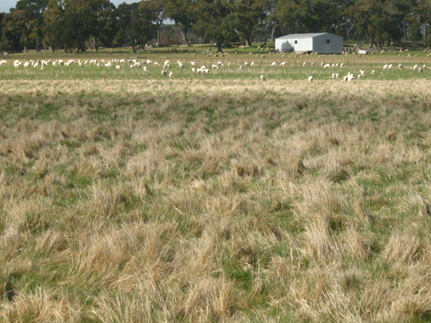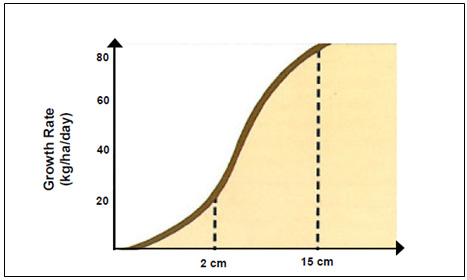Developing a bent grass control program
How do you break the dominance of bent grass and get started on a control program?
Initially soil fertility must be built up to create a suitable environment for productive species to thrive.
Adjustments to grazing management can be made to improve the use of bent grass and increase the competition of desirable species over bent grass.
Spray topping of bent grass may also enable farmers to start managing bent grass better.
Increase soil fertility
In typical sedimentary soils with an Olsen Phosphorus it may take 20kg of phosphorus per hectare per year. For 3 to 4 years before levels can be reduced to a maintenance rate (approx 1 kg/P/DSE or Dry Sheep Equivalent).
If you are in a sub clover zone, you will need to raise Olsen P levels to at least 12ppm for sub clover to thrive and if you are aiming at establishing productive white clovers, an Olsen P level of 15ppm or more would be necessary. If soils are strongly acidic, then lime will also need to be added.
Build up and maintain soil nitrogen levels before you sow improved perennial grasses, recognising that even in well managed pastures, clover dominance is cyclical. As nitrogen builds up, high fertility grasses will dominate until the nitrogen level starts to decline again.
Although you should aim to obtain most of your nitrogen from clover, there may be opportunities to apply some nitrogen in late August, perhaps as urea, to hasten the start of spring growth. This will be dependant on the feed requirements of the livestock.
Applications of nitrogen in early spring are unlikely to adversely affect the clover or grass balance, providing the extra growth is used. If greater grazing pressure is achieved, the bent grass will be disadvantaged.
Pasture species selection
As graph 1 illustrates, soil fertility and rainfall are important factors in the competition of pasture species.
If you have relatively infertile soils, (Olsen P levels less than 8ppm) and cannot put on more than a maintenance level of P — you should opt for species better suited to your environment than perennial ryegrass and white clover.
Other options such as cocksfoot and sub clover may be more suitable.
If you are going to fertilise heavily — rotationally graze and increase summer stocking pressure. Sowing improved perennial grasses should be considered.
Cocksfoot
Cocksfoot and summer active tall fescues are more competitive than perennial ryegrass with less intensive management and are also better at competing against bent grass over a wet summer. Perennial ryegrass will go dormant but cocksfoot will respond to the summer rain, use up soil moisture and reduce the invasiveness of bent grass. Cocksfoot and summer active tall fescue pastures may have less clover and a winter feed shortage so it is worth while trying to encourage more winter active species on at least some paddocks.
Perennial clovers
Perennial clovers are better able to coexist with bent grass than annuals. Low growing, stoloniferous white clover cultivars compete well but fertility and grazing management must be well implemented. White clovers do not tolerate trampling any better than bent grass but they do colonise the bare patches left after trampling quicker than bent grass. Do not allow excess spring or early summer growth to out-compete white clover and do not over graze during dry summers.
Special purpose pastures
If you can't manage pasture growth on your entire farm, consider paying extra attention to a percentage of the farm. A relatively small area of high quality feed can have a large impact on productivity and profitability if used for the most valuable stock, and for the months where feed is limited (ewes before joining, at lambing, weaning and young stock).
Grazing intermittently to suit these stock can also improve pasture quality, providing timing and intensity are adequate.
If finances are limited, ensure that the best quality pastures are adequately fertilised and managed, even if it means that other paddocks will receive no fertiliser. It is possible to justify extra time and expenditure on such special purpose paddocks. As the system develops, the area of special purpose pastures can be increased.
Increasing your spring and summer stocking pressure
Increasing spring and summer grazing pressure may allow you to better use bent grass growth. Various options to consider are:
- spring lambing and calving (perhaps carrying the calves through for 18 months)
- hay or silage making
- spray topping
- slashing
- rationing winter feed
- feeding more supplements to carry more stock (this in particular applies to cattle).
Taking a paddock out of pasture for a summer fodder crop will also enable you to put more pressure on bent grass. This also will help to finish spring dropped lambs, (which can be a problem over a dry summer) and could be the start of an ongoing re-sowing program.
It is vitally important to use as much of the November and January feed surplus as possible to improve late summer pasture growth. This helps to get nutrients cycling and to leave relatively bare ground — such as 800 to 900kg DM per hectare — for clover to germinate at the autumn break.
It should be possible for mixed farms running self-replacing merinos to run twice the stocking rate over spring and summer than they do in winter. It should be noted that if you are in an area with unreliable summer rain, these strategies may result in an unacceptably high level of hand feeding.

Adopting a rotational grazing strategy
There have been a number of research trials to demonstrate an improvement in stock and pasture performance from rotational grazing. There may be advantages in terms of pasture composition changes and feed allocation too.
Summer active species, such as cocksfoot, tall fescue and white clover can be killed by constant heavy grazing over summer. This is because the rate of removal of root reserves will be greater than the rate of replacement. Occasional spells over winter will enable these more upright and rapidly growing species to capture more sunlight than bent grass and compete better.
Pasture growth rates are higher when pastures are kept above 2cm in height due to intercepting more sunlight and converting it into growth. When pastures reach heights of 12 to 15cm, pasture growth slows due to shading and death of older leaves. 
Controlled grazing
Prime lamb producers, whose paddocks are not dominated by bent grass, may consider the controlled grazing approach. This basically involves allocating feed to the sheep based on condition score and then grazing on a rotational basis. Ewe condition at joining is the most important determinant of weaning percentage. Ewes should be joined on a rising plane of nutrition. The paddock can then be set stocked and stock given quality feed, (which has been saved by the winter rationing) at lambing until weaning. For example, this may involve running 1000 ewes greater than per hectare and moving them every 1 to 2 days over winter on a 70 to 100 day rotation.
The system requires close monitoring of:
- animal condition
- animal requirements
- pasture availability and quality.
It may also require the use of electric fencing.
Combined with high applications of fertiliser, this strategy improves pasture growth rates and utilisation. It also allows more stock to be carried and reduces the dominance of bent grass.
Winter rotational grazing
Heavy winter rotational grazing of highly dominated bent grass paddocks should only be attempted with wethers plus cattle if available and when pugging won't occur. Trampling the bent grass will allow ryegrass to out-compete it, but it will reduce stock condition. Keep in mind that major changes in feed type or quality may affect wool quality.
If intensive rotations are inappropriate, you should at least consider occasional spells in set stocked paddocks. As perennial grasses re-grow after grazing, they use up carbohydrate reserves in their root system and tillers until they reach a height of 2cm when they are able to photosynthesise enough to start replacing root reserves.
Continuous grazing of a mixed pasture containing bent grass, ryegrass, cocksfoot and clover will enable stock to constantly and selectively nip off the most rapidly growing species. This depletes root reserves and progressively reduces regrowth vigour. Plants can die after being grazed a number of times with no opportunity to replenish root reserves.
Perennial ryegrass takes about 30 days to replace a grazed off leaf in mid-winter, 60 days for two leaves. A spell of 6 weeks is less than ideal but it will enable plants to replace some reserves. For example, a two week on, six weeks off rotation around four paddocks will therefore be beneficial to control bent grass.
The value of this rotation will be increased if some cattle are used as well. The extra trampling damage over winter will give ryegrass an edge over bent grass. As cattle graze less selectively than sheep, they will eat seed heads and rank growth in spring/summer, which will reduce the accumulation of surplus feed in late summer.
Summer rotational grazing
Summer rotational grazing is unlikely to be beneficial for bent grass control in a dry summer unless desirable summer active species are present.
Spray topping
Spray topping can assist in breaking the cycle of bent grass dominance and is used in conjunction with changing soil fertility and grazing management.